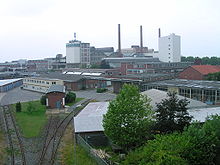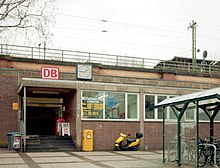Rothe earth
|
Rothe earth
City of Aachen
|
|
|---|---|
| Coordinates: 50 ° 46 ′ 35 ″ N , 6 ° 7 ′ 20 ″ E | |
| Height : | approx. 175 m |
| Area : | 1.64 km² |
| Residents : | 2597 (December 31, 2016) |
| Population density : | 1,584 inhabitants / km² |
| Postal code : | 52068 |
| Area code : | 0241 |
Rothe Erde is a district of Aachen that has been shaped by large-scale industry and has existed since April 1, 1906 . It is the statistical district 34 in the Aachen-Mitte district . It lies between the districts of Forst and Eilendorf . From 1999 to 2010, the district was included in the Social City funding program together with the entire eastern district of Aachen and it was fundamentally modernized in terms of urban planning, transport technology and culture.
Name, history and economy
The original village was called Röthgen. The surrounding district was called Rothe Erde and gave the later new settlement its name. Both terms are clearing names. The hamlet and its name have perished and are only preserved in the names of the Rödgerbach, Rödger Straße and Rödger Au.
Rothe Erde is a historically important steel location. In 1845, the Walloon Jacques Piedbœuf founded the steelworks OHG Piedboeuf & Co, Aachener Walz- und Hammerwerk, together with the entrepreneur Hugo Jakob Talbot and the mechanical engineers Johann Leonhard Neuman and Theodor Esser on a former estate , which was operated after the takeover of Carl Ruëtz in 1851 henceforth as the limited partnership Carl Ruëtz & Co - Aachener Hütten-Aktien-Verein Rothe Erde was continued. Carl Ruëtz bought what was then Paulinenhütte in Dortmund in 1861, which has been called Rothe Erde Dortmund ever since , and handed over the Aachen ironworks to the mining industrialist Adolph Kirdorf .
Since there was no blast furnace in Rothe Erde in which the iron ore could be smelted into pig iron , from 1892 Kirdorf acquired several blast furnace plants and collieries both in Esch-sur-Alzette in Luxembourg , which belonged to the German Customs Union , and in the Community of Audun-le-Tiche / Deutschoth in Lorraine , which had been part of the German Empire since 1871 . He received the required amount of coal and coke from Gelsenkirchener Bergwerks-AG , where his brother Emil was also the commercial director at the time. Kirdorf's strategy paid off and by 1887 the Aachener Hütten-Aktien-Verein Rothe Erde took first place among German steelworks with a crude steel production of around 500,000 tons and increased this result to over a million tons of crude steel ingots by 1890.
On January 1, 1905, the iron and steel works joined forces with the Schalke Mine and Ironworks Association , which ultimately resulted in a formal merger in 1907 under the umbrella of Gelsenkirchener Bergwerks-AG. In 1906, the Eschweiler wire factory was added, which was badly damaged that year by a flood of the Inde .
After the founding and completion of the Adolf-Emil-Hütte in Esch-sur-Alzette in 1912, the Aachener Hütten-Aktien-Verein, which now has eleven blast furnaces, counted alongside the local Arbed with 15 blast furnaces and the German-Luxembourgish mining and ironworks AG of the Ruhr industrialist Hugo With nine blast furnaces, Stinnes is now one of the most important heavy industry companies in Luxembourg .
After the First World War and the associated collapse in the supply of raw materials, both due to the collapse of the smelters and mines in Lorraine and Luxembourg's exit from the German Customs Union, as well as the loss of sales markets in eastern Germany due to the Allied occupation of the Rhineland , Kirdorf was forced to leave the Aachener Selling the company to the Franco-Belgian-Luxembourg consortium Société Métallurgique des Terres Rouges under the leadership of the Luxembourg steel group Arbed . In 1926 the factories were shut down and mostly dismantled .
As early as 1886, fertilizers were initially produced from the smelting waste product, Thomas phosphate slag, in its own slag mill. Around 150,000 tons of phosphate flour for agriculture were produced here every year. After the smelter was closed, Karl Gustav Schmidt acquired the remaining rubble in order to use the slag as an original Aachener Rothe Erde for sports fields throughout Europe, including the Berlin Olympic Stadium from 1936, but also the former Borussia Dortmund football stadium, the Rote Erde Stadium , market.
In 1929, the tire manufacturer O. Englebert Fils & Co. , which merged with Uniroyal in 1958 and traded as Uniroyal Englebert Deutschland AG , set up shop on the site of the iron and steel works . After the takeover by Continental AG , the company's headquarters were relocated to Hanover, but a tire production facility was retained. In contrast, the former head office building was auctioned at the highest bidder in 2009 and is now used in a commercial mix of branches. Actimonda BKK has been the main tenant since 2012 .
In 1949, in the immediate vicinity and belonging to the Rothe Erde district, the construction of the Rothe Erde industrial park began, on which Philips Germany GmbH set up a light bulb and glass factory, which also took over the production of picture tubes from 1954. From around the turn of the century, and after Philips has structurally changed, specialized and thus reduced in size, the Rothe Erde industrial park is used by several and different companies.
religion
In the last quarter of the 19th century, Rothe Erde had grown fourfold. Since the majority of the population was Catholic, the establishment of a separate pastoral care district had become inevitable. This was established with the parish of St. Barbara, which has been independent since 1901 and named after the patron saint of miners and smelters. A coat of arms on the church still reminds of this large-scale industry. Previously been held since 1731 at the Good Earth Small Rothe , a private chapel in 1735 on the initiative of the then auxiliary bishop of Cologne benediziert was. After its construction from 1864, the parish church of St. Severin in Eilendorf was responsible for the Catholics, which remained the mother parish even after the consecration of St. Barbara. The foundation stone of the Barbarakirche took place in 1900 and the inauguration in 1901. In 1944 it suffered severe war damage and was restored in 1957 and extensively restored in 1974/1975. In March 2019 the church was profaned and the church complex was sold to the parish “ New Life ” for use as a Protestant free church.
As of December 31, 2003, the statistical district of Rothe Erde had 2,634 inhabitants on 164 hectares with a proportion of foreigners of almost 31%. About 1,300 people belonged to the Catholic faith.
traffic
The nearest train station is Aachen-Rothe Erde train station . The next motorway junctions are Aachen-Brand on the federal motorway 44 and Aachen-Rothe Erde on the federal motorway 544 .
literature
- Michael Käding: Red (h) e earths. In: Paul Thomes (Ed.): Raw material base and sales market. The heavy industry of the Grand Duchy of Luxembourg and the Aachen Revier (= Aachen studies on economic and social history. Vol. 2). Shaker, Aachen 2005, ISBN 3-8322-4310-0 , pp. 13-20.
- Michael Käding: History of the Aachener Hütten-Aktien-Verein Rothe Erde. In: Paul Thomes (Ed.): Raw material base and sales market. The heavy industry of the Grand Duchy of Luxembourg and the Aachen Revier (= Aachen studies on economic and social history. Vol. 2). Shaker, Aachen 2005, ISBN 3-8322-4310-0 , pp. 83-142.
Web links
- History of the Rothe Erde company
- Historic Hüttenstrasse on the side of the city of Aachen
- Red (h) e earths
- Peter Packbier: Rothe Erde and Eilendorf - history of the Rothe Erde district. (PDF; 1.4 MB) In: Eilendorf and the Aachen region in their history . Retrieved March 18, 2018 .
Individual evidence
- ↑ Population statistics (, csv) December 31, 2016. Retrieved July 4, 2017 .
- ↑ Peter pack of beer: Rothe Erde and Eilendorf - History of the district Rothe Erde. Retrieved August 6, 2019 .






